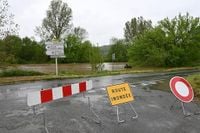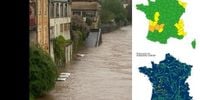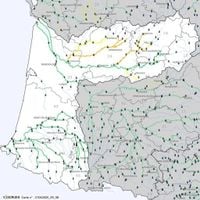Heavy rain and storms have left parts of southwestern France grappling with severe flooding, prompting authorities to issue orange alerts for the departments of Dordogne, Corrèze, and Gironde. The situation escalated over the weekend, with rivers swelling to unprecedented levels, causing extensive property damage and leading to emergency evacuations.
On Sunday, April 20, 2025, Gironde was placed on orange alert for flood risks, joining Dordogne and Corrèze, which had already been under alert since Saturday, April 19, 2025. The Vézère and Isle rivers, in particular, have overflowed, reaching heights not seen in decades, especially around Montignac, where the water rose dramatically.
In Dordogne, firefighters responded to approximately 28 emergency calls related to flooding on Sunday. Most interventions were focused on securing property and evacuating vehicles, as the rising waters submerged streets and parked cars in towns like Le Bugue. Local media reported that some vehicles were almost entirely underwater by Sunday morning.
“They came with diving suits to tie up the cars,” said Le Bugue's mayor, Serge Léonidas, in a statement to Sud Ouest. “We had put up signs the day before, but people didn't heed the risks.” Fortunately, there were no reports of injuries or casualties, according to Dordogne’s deputy prefect, Nicolas Dufaud.
As the rain continued, authorities warned that flood peaks were expected on Monday morning, April 21, 2025. In Montignac-Lascaux, the Vézère river rose nearly three meters in just two hours, an event described as unprecedented by Montignac's mayor, Laurent Mathieu. “It increased by 2.8 meters in two hours which is unheard of. I have never seen the river rise that fast,” he shared with ici Périgord.
Local businesses, including the Parc du Bournat amusement park, were also affected, with the park announcing it would remain closed due to impassable parking lots. “The heavy rain has made our parking lots impassable, and we have to wait for the water to recede,” they stated.
In addition to the flooding, up to 1,100 homes in the region were left without power on Monday morning, as trees fell on power lines due to the severe weather conditions. The prefecture confirmed that electricity restoration efforts were underway.
Emergency services have also been busy evacuating individuals from campsites, with around 100 people relocated, particularly from areas further upriver in Terrasson. The situation remains dynamic, as the Dronne river, which runs through five departments before joining the Isle at Coutras in Gironde, was still rising, with levels expected to peak between 10 a.m. and noon on Monday.
Residents have been advised to avoid affected areas, and Météo-France has urged the public to stay informed and heed safety instructions. “Dangerous weather is expected. Stay informed and observe any official instructions,” they cautioned.
As the situation evolves, local authorities are preparing for the worst, with emergency plans already activated. The Dordogne Secours Populaire has launched an initiative to provide material and financial aid to those affected, stating that assistance will be available regardless of the victims' financial situations.
In Saint-Léon-sur-Vézère, Gué Kusters, manager of the Le Paradis campsite, took proactive measures to ensure the safety of his guests amidst rising waters. “We’ve had to secure the area and make sure everyone is safe,” he noted.
Despite the alarming conditions, some local officials expressed confidence in their preparedness for flooding. “We are used to dealing with flooding in our little village,” stated Saint-Léon-sur-Vézère's mayor, Yannick Dalbavie, in an interview with Le Figaro. “Everything has been anticipated - there is no problem.”
However, the rising waters have created significant challenges, with the prefecture of Dordogne reporting around fifty interventions by firefighters since the onset of the flooding. Five campsites were evacuated, and 25 residents were assisted in leaving their homes as a precautionary measure.
As the floodwaters began to recede in some areas, the situation remains precarious. The Vézère river had reached over five meters early on Monday, but authorities anticipated a decline before noon. Meanwhile, the level of the Céou river has started to fall, although concerns linger over the Dronne river's rising levels.
In summary, the heavy rainfall and subsequent flooding have created a challenging situation for many in southwestern France. With emergency services working tirelessly to manage the crisis, the focus remains on ensuring public safety and providing support to those affected by the deluge.








